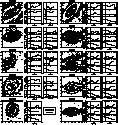A sub-sample of 56 galaxies whose nuclear structures
were interpreted in terms of the ellipse fitting on near-IR
images was constructed (16 other galaxies of the survey
are seen nearly edge-on and were
not analyzed in detail). Our principal results are the following.We classify 17 galaxies of the subsample as having two triaxial structures,
either double bars or a bar with an embedded triaxial bulge (some cases
are speculative because of low-central resolution or high galactic
inclination).
Two of them (NGC 1433 and 6782) were known to possess a double-barred
morphology from previous surveys in other colors, 15 detections are
new (NGC 613, 1079, 1353, 1365, 1398, 1808, 1512, 2217, 2935, 3368, 3393,
4984, 5101, 5566 and ESO 437-67).
We find 16 other nuclear isophotal twists
not associated with a clear ellipticity maximum (14 of them are new:
NGC 1187, 1832, 2442, 2525, 2997, 3166, 3637, 3673, 3887, 4454,
4612, 4665, 5643, 5701; twists in NGC 1302 and 1512 were known from other
bands).
We detect central triaxial features (nuclear bars or triaxial bulges)
in three galaxies classified as SA in RC3: NGC 1792, 4438 and 5427.
On the other hand, we find no evidence for triaxiality in the following
SA's: NGC 2911, 4212, 4501, 4689 and 6753.
Four of our 17 double-barred galaxies host a Seyfert nucleus:
NGC 613, 1365, 1808, 3393 (Seyfert activity of NGC 1808 is controversial).
Among 9 Seyferts from the sub-sample, there are 4 with
a double bar (see item 4), 2 with a nuclear bar (NGC 4438 and 5427),
1 with a strong twist along its large-scale bar (NGC 5643) and
2 show no clear twist (NGC 2911 and 4501).
Nine of our double-barred galaxies are known to have a nuclear ring
(NGC 1433, 1512, 1808, 2935, 4984, 6782 and ESO 437-67) or a nuclear spiral
(NGC 613 and 1365).
Among 32 galaxies with double barred structure or twist,
29 are of early Hubble types (S0-Sc);
only 3 are of late type Sc: NGC 1187, 2525, 2997, 5643.
Twists in the first 3 Sc's are small (![]() ) and can be caused
by projection effects; the twist in NGC 5643 - which is a Seyfert emitter
- is strong and probably intrinsic. No Sc galaxy with a twist has
been known so far.
Comparison of the present survey with photometry in other
colors and with kinematical data, as well as the interpretation,
will be done in a separate paper.
) and can be caused
by projection effects; the twist in NGC 5643 - which is a Seyfert emitter
- is strong and probably intrinsic. No Sc galaxy with a twist has
been known so far.
Comparison of the present survey with photometry in other
colors and with kinematical data, as well as the interpretation,
will be done in a separate paper.
Acknowledgements
The authors acknowledge the participation of M. Shaw on the selection of the observed sample of galaxies. B.J. wishes to express many thanks to P. Lena, J.-P. Zahn and J. Palouš for their efforts in co-organizing the PhD "cotutelle'' between University Paris VII and Charles University in Prague, and, especially, to F. Combes for having accepted to co-direct his PhD thesis. He also acknowledges useful discussions on data reduction techniques with J.M. Deltorn as well as the help of H. Flores with software problems. The stay of B.J. at the Paris Observatory was supported by a scholarship of the French Government.

Figure 4:
Contour plots and ellipse fitting. The left box
shows logarithmically scaled intensity map on the area of ![]() arcseconds; the North is at the top, the East at the left.
The ellipse fitting output - radial profiles
of ellipticity, position angle and surface brightness -
is displayed in the central plot; the abscissa - semi-major axis of
fitted ellipses - is scaled logarithmically. The right plot
shows the same quantities after deprojection. The vertical dash-dot
lines in radial profile plots separate the innermost region
of a<3'' where the ellipse fitting is judged to be unreliable
arcseconds; the North is at the top, the East at the left.
The ellipse fitting output - radial profiles
of ellipticity, position angle and surface brightness -
is displayed in the central plot; the abscissa - semi-major axis of
fitted ellipses - is scaled logarithmically. The right plot
shows the same quantities after deprojection. The vertical dash-dot
lines in radial profile plots separate the innermost region
of a<3'' where the ellipse fitting is judged to be unreliable